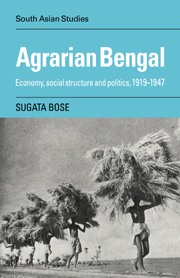Book contents
- Frontmatter
- Contents
- List of maps
- Preface
- List of abbreviations
- PART I AGRARIAN ECONOMY AND SOCIETY: STRUCTURE AND TRENDS
- PART II PEASANTS AND POLITICS
- 6 Agrarian class conflict, nationalism and communalism in east Bengal
- 7 Agrarian relations and mass nationalism in west Bengal
- 8 Sharecroppers' agitations in the frontier regions
- Conclusion
- Glossary
- Select bibliography
- Index
7 - Agrarian relations and mass nationalism in west Bengal
from PART II - PEASANTS AND POLITICS
Published online by Cambridge University Press: 24 October 2009
- Frontmatter
- Contents
- List of maps
- Preface
- List of abbreviations
- PART I AGRARIAN ECONOMY AND SOCIETY: STRUCTURE AND TRENDS
- PART II PEASANTS AND POLITICS
- 6 Agrarian class conflict, nationalism and communalism in east Bengal
- 7 Agrarian relations and mass nationalism in west Bengal
- 8 Sharecroppers' agitations in the frontier regions
- Conclusion
- Glossary
- Select bibliography
- Index
Summary
Peasant protest in west Bengal, especially during the depression decade, was much more muted than in east Bengal. It was also very different in character. Midnapur was an exception in some ways; nowhere else in west Bengal did the agitations reach the same degree of intensity. In 1942 there was a climax of a succession of agrarian-based nationalist agitations that had been launched in this coastal district of south-west Bengal since 1921. In west Bengal as a whole, major agrarian movements in this period invariably assumed an anti-government complexion and usually did not outlast the initial phase of a crisis. During these short outbursts, the countryside displayed remarkable solidarity – the conflict with the local arms of the colonial state over-shadowed the differences within the rural populace. In the periods of interregnum, the internal conflicts became apparent. In most parts of west Bengal, the grainlending landlords and rich peasants were able to reassert their dominance over the peasant smallholders and agricultural labourers during the 1930s depression. It was only in Contai and Tamluk in Midnapur, Arambag in Hooghly, and a few other small pockets, that the indebted small peasants and sharecroppers were able to achieve a measure of success in their collective bargaining with the rentiers and creditors. This chapter will provide a brief analytic survey of the connections between agrarian relations and mass nationalism in west Bengal.
- Type
- Chapter
- Information
- Agrarian BengalEconomy, Social Structure and Politics, 1919-1947, pp. 233 - 251Publisher: Cambridge University PressPrint publication year: 1987



